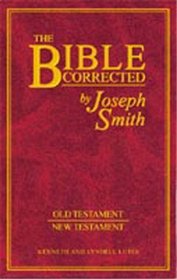Search -
THE BIBLE CORRECTED by Joseph Smith
THE BIBLE CORRECTED by Joseph Smith
Author:
"Judge not, that ye be not judged." Joseph Smith's inspired translation of the Bible restores the original text as, "Judge not unrighteously, that ye be not judged; but judge righteous judgment." Thousands of inspired corrections are shown in this manner as you read the King James Version of the Bible. Text that is in error is shown by stri... more »
Author:
"Judge not, that ye be not judged." Joseph Smith's inspired translation of the Bible restores the original text as, "Judge not unrighteously, that ye be not judged; but judge righteous judgment." Thousands of inspired corrections are shown in this manner as you read the King James Version of the Bible. Text that is in error is shown by stri... more »
ISBN-13: 9781890558598
ISBN-10: 1890558591
Publication Date: 8/10/1999
Pages: 352
Edition: 2 ed
Rating: ?
ISBN-10: 1890558591
Publication Date: 8/10/1999
Pages: 352
Edition: 2 ed
Rating: ?
0 stars, based on 0 rating
Publisher: Lutes International
Book Type: Hardcover
Other Versions: Paperback
Members Wishing: 1
Reviews: Amazon | Write a Review
Book Type: Hardcover
Other Versions: Paperback
Members Wishing: 1
Reviews: Amazon | Write a Review




